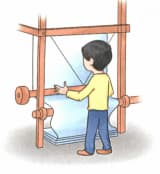Natural fibres are waterproof and germ free.
Important Questions on Fibre to Fabric
Fill in the blank with a suitable word:
Red, blue and yellow are the three _____ (secondary/primary) colours.
Observe the picture and choose the appropriate word from the following to fill the blank.
(weaver, tailor, carpenter)

A _____ is a person who works on looms and weaves clothes.
Choose the correct word from the given brackets and fill in the blank:
[Silk, Wool, Cotton, Nylon]
_____ is a very expensive natural fibre.
Fill in the blank with an appropriate word:
Linen and _____ (polyesters/cotton/polyamides) are examples of natural fibres.
Choose the correct option from the following:
(first, second, third)

The picture shown above is of a _____ class lever.
Fill in the blank with a suitable word:
By mixing blue and yellow colours, we get _____ (green/grey) colour.

